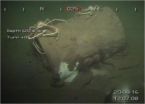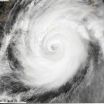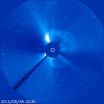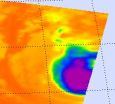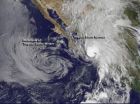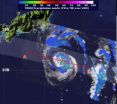(Press-News.org) CHAMPAIGN, Ill. — University of Illinois researchers have a new low-cost method to carve delicate features onto semiconductor wafers using light – and watch as it happens.
"You can use light to image the topography and you can use light to sculpture the topography," said electrical and computer engineering professor Gabriel Popescu. "It could change the future of semiconductor etching."
Chip makers and semiconductor researchers need to very precisely control the dimensions of their devices. The dimensions of the components affect performance, speed, error rate and time to failure.
Semiconductors are commonly shaped by etching with chemicals. Etching errors, such as residual layers, can affect the ability to further process and etch as well as hamper device performance. Thus, researchers use time-consuming and costly processes to ensure precise etching – for some applications, to within a scant few nanometers.
The Illinois researchers' new technique can monitor a semiconductor's surface as it is etched, in real time, with nanometer resolution. It uses a special type of microscope that uses two beams of light to very precisely measure topography.
"The idea is that the height of the structure can be determined as the light reflects off the different surfaces," said electrical and computer engineering professor Lynford Goddard, who co-led the group with Popescu. "Looking at the change in height, you figure out the etch rate. What this allows us to do is monitor it while it's etching. It allows us to figure out the etch rate both across time and across space, because we can determine the rate at every location within the semiconductor wafer that's in our field of view."
(See a video of Goddard narrating a real-time recorded etching at http://www.youtube.com/watch?v=6tIJqNrV20s&feature=plcp)
The new method is faster, lower in cost, and less noisy than the widely used methods of atomic force microscopy or scanning tunneling microscopy, which cannot monitor etching in progress but only compare before and after measurements. In addition, the new method is purely optical, so there's no contact with the semiconductor surface and the researchers can monitor the whole wafer at once instead of point-by-point.
"I would say the main advantage of our optical technique is that it requires no contact," Popescu said. "We're just sending light, reflected off the sample, as opposed to an AFM where you need to come with a probe close to the sample."
In addition to monitoring the etching process, the light catalyzes the etching process itself, called photochemical etching. Traditional chemical etching creates features in steps or plateaus. For curved surfaces or other shapes, semiconductor researchers use photochemical etching. Usually, light shines though very expensive glass plates called masks that have distinct patterns of gray to let light through by degrees. A researcher must purchase or make a mask for each tweak of a pattern until the correct pattern of features is achieved.
By contrast, the new method uses a projector to shine a grayscale image onto the sample being etched. This allows the researchers to create complex patterns quickly and easily, and adjust them as needed.
"To create each mask is very expensive. That's impractical for research," Goddard said. "Because our technique is controlled by the computer, it can be dynamic. So you can start off etching one particular shape, midway through realize that you want to make some change, and then change the projector pattern to get the desired outcome."
The researchers envision this technology applied beyond etching, to real-time monitoring of other processes in materials science and life science – for example, watching carbon nanotubes self-assemble, or error monitoring during large-scale computer chip manufacturing. It could help chip manufacturers reduce costs and processing time by ensuring that equipment stays calibrated.
INFORMATION:
The National Science Foundation supported this work, published Sept. 28 in the journal Light: Science and Applications. Goddard and Popescu are also affiliated with the Beckman Institute for Advanced Science and Technology at the U. of I. Graduate students Chris Edwards and Amir Arbabi were also co-authors of the paper.
Editor's note: To contact To reach Lynford Goddard, call 217-244-0799; email lgoddard@illinois.edu.
To reach Gabriel Popescu, 217-333-4840; gpopescu@illinois.edu.
The paper, "Optically Monitoring and Controlling Nanoscale Topography During Semiconductor Etching," is available online at http://www.nature.com/lsa/journal/v1/n9/full/lsa201230a.html.
New method monitors semiconductor etching as it happens -- with light
2012-09-29
ELSE PRESS RELEASES FROM THIS DATE:
Tadpole shrimp a new pest of rice in the midsouthern United States
2012-09-29
Tadpole shrimp are pests of rice production systems in California and have recently been found impacting Missouri and Arkansas rice fields. The shrimp feed on rice seedlings and uproot them during foraging, and their foraging behavior causes water to become muddy, which reduces light penetration to submerged seedlings and delays the development of the rice plant.
In "Review of a New Pest of Rice, Tadpole Shrimp (Notostraca: Triopsidae), in the Midsouthern United States and a Winter Scouting Method of Rice Fields for Preplanting Detection," a new open-access article appearing ...
Bored? Researchers shed light on why
2012-09-29
This gives new meaning to the complaint "I'm bored" — literally.
Canadian researchers — including a professor from the University of Guelph — have come up with a new, precise definition of boredom based on the mental processes that underlie the condition.
Although many people may see boredom as trivial and temporary, it actually is linked to a range of psychological, social and health problems, says Guelph psychology professor Mark Fenske. He's among authors of a new study in Perspectives on Psychological Science, published by the Association for Psychological Science.
Boredom ...
Time bomb: Military ordnance in Gulf poses threat to shipping, says Texas A&M proffesor
2012-09-29
Millions of pounds of unexploded bombs and other military ordnance that were dumped decades ago in the Gulf of Mexico, as well as off the coasts of both the Atlantic and Pacific oceans, could now pose serious threats to shipping lanes and the 4,000 oil and gas rigs in the Gulf, warns two Texas A&M University oceanographers.
William Bryant and Neil Slowey, professors of oceanography who have more than 90 years of combined research experience in all of the Earth's oceans, along with fellow researcher Mike Kemp of Washington, D.C., say millions of pounds of bombs are scattered ...
IUCN adopts new 'Green List' to show species on the path to conservation success
2012-09-29
The IUCN World Conservation Congress has adopted a motion sponsored by the Wildlife Conservation Society and partners to create a Green List to assess conservation success. The Green List for Species would include species identified as 'fully conserved,' which are those that exist in ecologically significant numbers, interacting fully with other species in their ecosystems.
The motion was adopted at the World Conservation Congress, which was held this month in Jeju, Republic of Korea.
The aim of the Green List is to highlight species that are thriving parts of a healthy ...
NASA sees super Typhoon Jelawat Affecting Japan
2012-09-29
Super Typhoon Jelawat is a large and powerful storm that has been bringing very rough seas to areas in the western North Pacific. NASA's Terra satellite passed over the monster storm and captured a visible image as it nears the big island of Japan.
NASA's Terra satellite passed over Super Typhoon Jelawat on Sept. 28 at 0238UTC (10:38 p.m. EDT, Sept. 27) and the Moderate Resolution Imaging Spectroradiometer captured an infrared image as the storm approaches Okinawa, Japan.
Jelawat's center passed by Ishigaki-jima by 1500 UTC (11 a.m. EDT) on Sept. 28 and was approaching ...
NASA sees sun unleash a wide, but benign, CME
2012-09-29
The sun erupted with a wide, Earth-directed coronal mass ejection (CME) on Sept. 27, 2012 at 10:25 p.m. EDT. CMEs are a phenomenon that can send billions of tons of solar particles into space that can reach Earth one to three days later, affecting electronic systems in satellites and on the ground. Experimental NASA research models estimate that the CME is traveling at around 700 miles per second and will reach Earth on Sept. 29.
CMEs of these speeds are usually benign. In the past, similar CMEs have caused auroras near the poles but have not caused disruption to electrical ...
NASA sees stubborn Nadine intensify into a hurricane again
2012-09-29
Infrared data from NASA's Aqua satellite today, Sept. 28, revealed strong convection and thunderstorms have built up again in Tropical Storm Nadine as it moved over warm waters in the Eastern Atlantic Ocean. That convection strengthened Nadine back into a hurricane today. Nadine has lasted over two weeks, but is nowhere near breaking the record for longest-lived tropical cyclone.
NASA's Aqua satellite passed over long-lived Nadine on Sept. 28 at 0441 UTC (12:41 a.m. EDT) when it was still a tropical storm and the Atmospheric Infrared Sounder (AIRS) instrument captured ...
NASA sees Tropical Storm Miriam takes final bow, replaced by Norman
2012-09-29
The National Hurricane Center issued their last advisory on Miriam on Sept. 27 at 11 p.m. EDT when it became a remnant low pressure area. At that time, the center of post-tropical cyclone Miriam was located near latitude 22.0 north and longitude 116.7 west, just over 400 miles west of the southern tip of Baja California. Miriam had maximum sustained winds near 30 knots (35 mph/55 kmh).
NOAA's GOES-15 satellite captured an infrared image of Tropical Storm Miriam and a developing low pressure area in the Eastern Pacific on Sept. 28 at 1145 UTC (7:45 a.m. EDT), off the coast ...
NASA sees many things happening in Tropical Storm Ewiniar
2012-09-29
There are a number of things happening under the hood of Tropical Storm Ewiniar's clouds that have been deciphered by satellite data today, Sept. 28, 2012, and NASA's TRMM satellite has noticed one area of heavy rainfall remaining.
NASA's Tropical Rainfall Measuring Mission (TRMM) satellite noticed light to moderate rainfall around most of the tropical storm, with the heaviest rainfall east of the center of circulation. Rainfall in that area was falling at a rate of 2 inches (50 mm) per hour).
Tropical Storm Ewiniar has a partially exposed low-level circulation center, ...
Notre Dame researchers part of team that discovered potentially dangerous new malaria mosquito
2012-09-29
University of Notre Dame entomologists are part of a team of researchers that recently discovered a potentially dangerous new malaria-transmitting mosquito. The as yet unnamed, and previously unreported, mosquito breeds in the western areas of Kenya and has an unknown DNA match to any of the existing malaria-transmitting species.
The Anopheles species of mosquitoes which transmits malaria in Africa is already widely studied by researchers. It prefers to rest indoors during the day and feed on humans during the night. Current malaria control programs, including spraying ...

